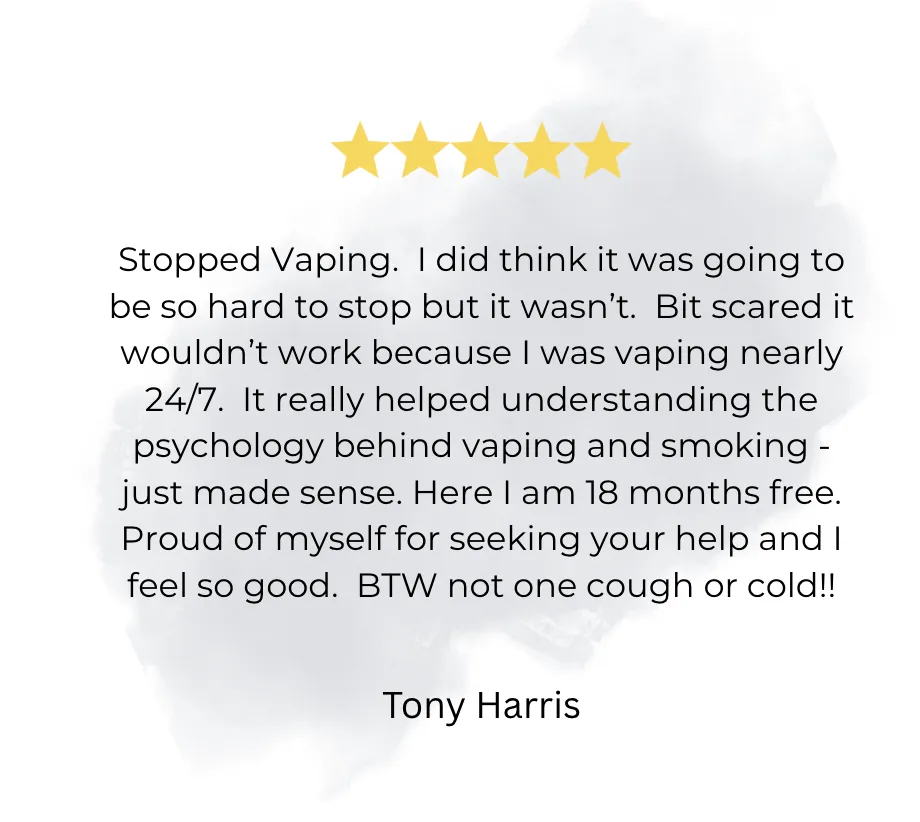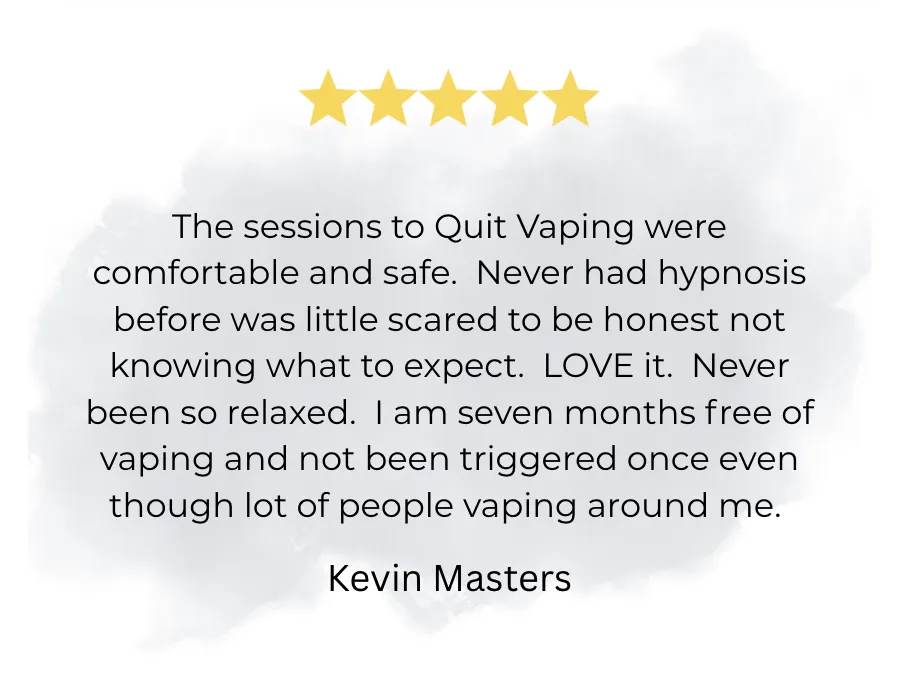T: 1300 72 31 36
Quit Vaping in Just 2 Sessions – For Good
Tried to quit vaping before and didn’t succeed?
Our proven 2-session hypnosis programme helps you stop vaping without stress, cravings, or relapse — even if nothing else has worked for you in the past.
Melbourne’s Most Trusted Quit Smoking Hypnosis Expert with 20+ Years of Experience helping smokers & vapers quit when nothing else worked.
QUIT VAPING HYPNOSIS MELBOURNE


The Real Struggles Vapers Face when Trying to Quit
If you’ve ever tried to quit vaping, you already know it’s not “just about willpower.” Most vapers struggle with more than just nicotine cravings — it’s the mental and emotional hooks that make quitting feel impossible.
Do you struggle with:...

Cravings and withdrawal that feel too strong to resist
Losing your go-to stress relief or "mental break"
Gaining weight once you quit
Breaking the vaping habits tied to your daily routine, like that morning coffee, after meals, while driving etc.
Being surrounded by friends or colleagues who still vape
Losing focus or productivity without your "quick hit"
Failing again because you've tried to quit before and didn't succeed
Missing vaping too much because it feels like part of your identity
Underestimating how habit forming vaping really is - until you try to stop
Feeling bored or restless without something in your hand or mouth
These challenges are real — but they’re not unbreakable. With the right approach, you can quit vaping without the constant struggle, cravings, or stress.
If you're vaping, you're still feeding the same habit as smoking!
The truth is, vaping activates the same neural pathways in your brain that smoking does—wiring and firing together to keep the habit locked in. Many vapes deliver far higher doses of nicotine than a single cigarette, making them even more habit forming.
Our Proven Solution to Quitting Vaping - for Good!
Quitting vaping doesn’t have to be a long, painful battle. At Melbourne Quit Smoking Clinic, we help vapers break free from nicotine and the mental habits that keep them hooked — in just 2 powerful sessions.
Our unique Quit Vaping Program combines:
Advanced Clinical Hypnosis – to rewire your subconscious patterns around vaping so the cravings disappear.
Mind-Body Techniques – proven methods to break habitual triggers, calm the mind, and eliminate the emotional pull toward vaping.
We address both the physical habits and the mental loops that keep you vaping, helping you feel calm, clear, and in control from day one.
We strengthen your new habits, remove any remaining triggers, and ensure you stay vape-free — without relying on patches, gum, or willpower alone.

This isn’t a generic “quit” method. It’s a tailored, results-driven approach that works with how your mind and body actually function — so you can stop vaping without the constant battle.
No cravings. No stress. No endless trying. Just freedom.
What our Clients are saying...



Why Our Clients Succeed
• Fast Results – Most clients stop vaping within the first session.
• No Harsh Withdrawal – Hypnosis helps reduce or even eliminate cravings.
• Support for Mind and Body – We address both the addiction and the habit.
• Lasting Change – Your new non-vaping identity is reinforced so you stay vape-free.
Your Next Step to a Vape-Free Life
You don’t have to spend months fighting cravings or worrying about relapse. You can quit vaping in just 2 sessions with a proven method that works.
The Quit Vaping Program consists of 2 consultations. The investment for this program is $795.00.
Book your Quit Vaping Program today to stop vaping and regain control over your health, your freedom, and your peace of mind.
📞 Call 1300 72 31 36
📍 Melbourne Quit Smoking Clinic – Helping clients quit smoking & vaping permanently
